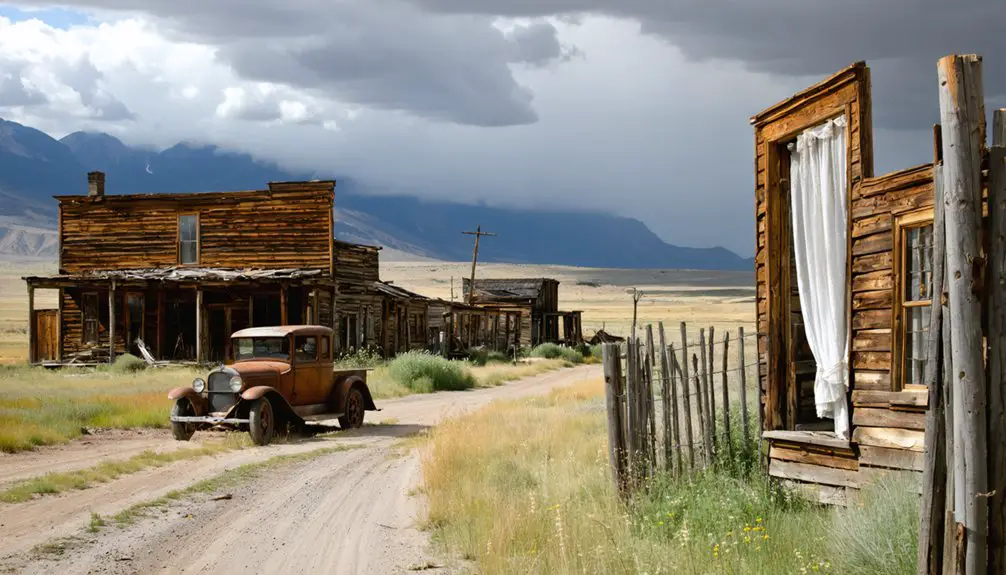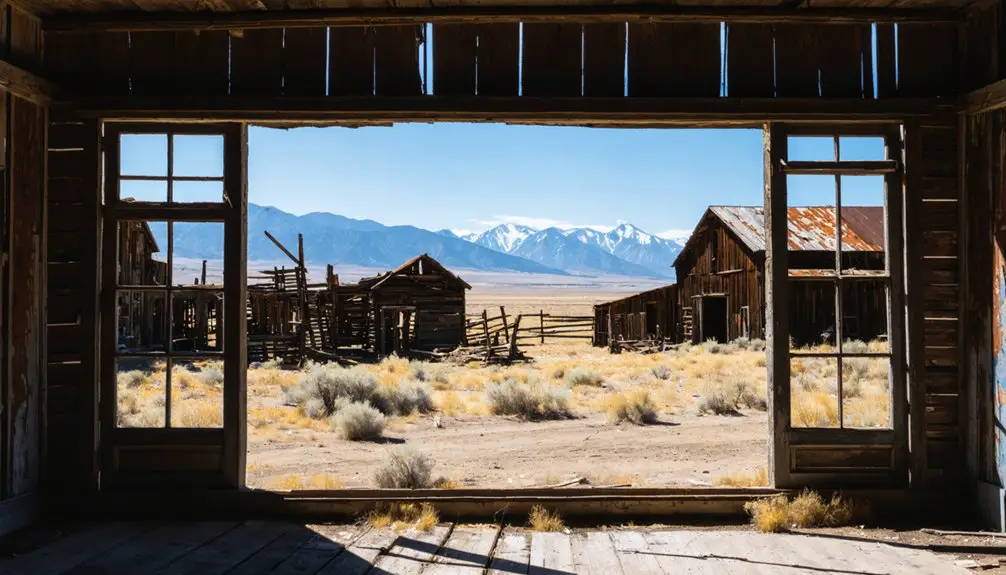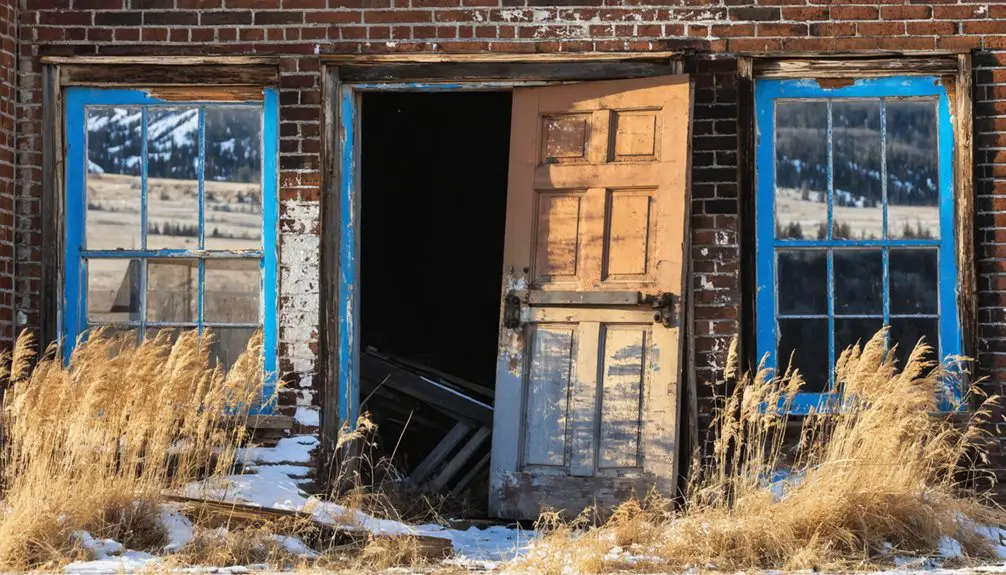You’ll discover a haunting memorial to Montana’s wild frontier days in Bannack, where the spirits of gold-seeking pioneers, ruthless outlaws, and vigilante justice still linger among the weathered buildings and forgotten graves. Ban’s Cemetery tells stories through its deteriorating markers, while the infamous Hotel Meade harbors unexplained encounters with ghostly children. The town’s dark history of mining accidents, disease outbreaks, and lawlessness reveals secrets that continue to unfold within its preserved ruins.
Key Takeaways
- Bannack, Montana became a ghost town after its gold mines were exhausted, leaving behind a legacy of violence and paranormal activity.
- Sheriff Henry Plummer’s 1864 execution for leading a criminal gang exemplifies the lawlessness that plagued Montana’s mining settlements.
- The Hotel Meade in Bannack is renowned for ghost sightings, particularly interactions with the spirits of children.
- Ban’s Cemetery preserves the town’s tragic history through deteriorating wooden markers and restored stone monuments from the 1860s.
- Preservation efforts maintain Bannack in “arrested decay,” allowing visitors to experience authentic remnants of the dangerous mining frontier.
The Dark History Behind Ban’s Cemetery
While Montana’s gold rush era brought promises of fortune and prosperity, Ban’s Cemetery stands as a somber memorial to the harsh realities of frontier life in 1860s Bannack.
You’ll find deteriorating wooden grave markers and restored stone monuments that tell tales of miners crushed in accidents, children claimed by disease outbreaks, and pioneers who succumbed to brutal winter conditions.
The cemetery reveals a complex tapestry of cultural rituals through its diverse burial practices, reflecting European immigrants and Native American traditions alike. The Chinese section featured shallow burial plots to allow for the traditional practice of exhuming remains for reburial in ancestral villages.
Through preserved inscriptions and religious symbols, you can trace the mainly Christian influences that shaped the community’s approach to death and remembrance. The town’s only church, built in 1877, held many of the funeral services for those laid to rest here.
Despite Bannack’s abandonment in the 1940s, the cemetery continues to serve as a powerful reflection of the true cost of America’s westward expansion.
Life and Death in Montana’s Mining Frontier
Although Montana’s mining frontier promised boundless opportunities, the harsh realities of frontier life in the 1860s created a stark contrast between wealth and survival.
While some struck it rich in booming towns like Helena, which boasted the world’s highest concentration of millionaires, frontier struggles claimed countless lives through mining accidents, disease outbreaks, and harsh conditions.
The discovery of gold at Bannack in 1864 sparked Montana’s first major mining rush, drawing thousands of hopeful prospectors to the territory.
You’ll find that these settlements transformed rapidly from rough camps into thriving communities, attracting diverse populations seeking fortune.
Yet beneath the surface of Victorian mansions and bustling commerce lay a precarious existence. Cave-ins, explosions, and inadequate medical care shortened life expectancy dramatically. Today, the Mining Archives Repository preserves detailed records of these dangerous conditions and tragic accidents.
When mines were exhausted, entire communities faced economic collapse, forcing families to migrate in search of new prospects, leaving behind ghost towns as evidence to the brutal nature of frontier mining life.
Paranormal Activity and Ghostly Encounters
In Montana’s most infamous ghost towns, paranormal activity serves as a haunting reminder of the region’s turbulent mining history.
You’ll encounter ghost sightings at Bannack’s Hotel Meade, where spirits particularly interact with children, and witness eerie phenomena like cold spots and slamming doors throughout the town’s historic structures.
At Gunslinger Gulch, you’ll face intense dark hauntings documented by paranormal investigators and featured on national television. The 52-acre property contains 19 haunted buildings including an old church, saloon, and jailhouse. Visitors have reported unexplained physical sensations, including being pushed and experiencing heavy atmospheres in the boarding house.
Butte’s notorious locations, including the Dumas Brothel and Cabbage Patch district, echo with supernatural encounters tied to their crime-filled past.
Whether you’re exploring Garnet Ghost Town’s Kelly’s Saloon, known for phantom laughter, or investigating the mysterious top floor of Dillon’s Metlen Hotel, you’ll find evidence of otherworldly residents who refuse to leave these abandoned settlements.
Preserving a Haunted Legacy
Since the late 1960s, dedicated organizations have worked tirelessly to protect Montana’s ghost towns from disappearing into history.
You’ll find their preservation techniques focus on “arrested decay,” which maintains buildings in their weathered state rather than fully restoring them – keeping their haunting authenticity intact.
The Montana Ghost Town Preservation Society leads these efforts, partnering with government agencies to safeguard everything from old saloons to blacksmith shops.
Working hand-in-hand with state officials, local preservationists fight to keep Montana’s historic buildings standing as testament to frontier ingenuity.
Their work guarantees you can experience the historical significance of the mining era while enjoying modern amenities.
Visitors who brave the winter months might encounter spectral figures dancing near the historic Kelley’s Saloon, adding to the supernatural intrigue of these preserved sites.
Through guided tours, educational programs, and immersive experiences like overnight stays in preserved cabins, you’re free to connect with Montana’s rich past.
Virginia City offers visitors a chance to experience authentic reenactments that bring the Old West to life.
Despite challenges like weather damage and limited funding, these preservation efforts continue to protect these irreplaceable windows into frontier life.
Untold Tales of Violence and Mystery
Behind Montana’s picturesque ghost towns lies a dark history of vigilante justice and untamed lawlessness that defined the American frontier.
You’ll find the echoes of this violent past in places like Bannack, where Sheriff Henry Plummer‘s double life as leader of the “Innocents” gang ended at the hangman’s noose in 1864. In mining boomtowns across the territory, swift and brutal vigilante justice became the law of the land. The imposing gallows still stand as a grim reminder of justice in the Old West.
These bloody episodes have spawned countless ghost stories, particularly in notorious locations like the Dumas Brothel in Butte and Gunslinger Gulch. The wicked reputation of these towns is exemplified by Taft, which the Chicago Tribune deemed “the wickedest city in America.”
Today, you can walk the same streets where gunfights erupted and vigilantes dispensed frontier justice. Paranormal investigators regularly report unexplained phenomena, from phantom gunshots to apparitions of miners, making these preserved towns living monuments to Montana’s deadly past.
Frequently Asked Questions
What Modern Safety Precautions Exist for Tourists Visiting These Dangerous Ghost Towns?
90% of ghost town injuries are preventable. You’ll find marked trails, safety gear requirements, guided tours, maintained structures, warning signs, emergency contact information, and on-site staff monitoring visitor activities.
Are There Any Ongoing Archaeological Excavations at Ban’s Ghost Town Site?
You won’t find any active archaeological excavations at Bannack today, as the site focuses on preservation rather than digging. Instead, ghost town history is maintained through structural conservation and above-ground historical interpretation.
How Can Visitors Legally Participate in Ghost Town Artifact Preservation Efforts?
You can join Montana Ghost Town Preservation Society events, volunteer for SHPO-approved archaeological digs, attend educational workshops, and participate in supervised artifact preservation activities through certified local government programs.
What Wildlife Hazards Should Tourists Be Aware of When Exploring?
Keep your eyes peeled for wildlife encounters with grizzlies, black bears, and mountain lions. You’ll need to watch for rattlesnakes, scorpions, and ticks while respecting unpredictable animal behavior.
Do Any Descendants of Original Mining Town Residents Still Live Nearby?
You’ll find descendant stories alive today, as several mining heritage families still maintain homes near Montana’s ghost towns, preserving their ancestors’ legacies through local historical preservation and community involvement.
References
- https://www.youtube.com/watch?v=8DRaKMLZvcs
- https://southwestmt.com/blog/ghost-town-terror-gunslinger-gulch/
- https://www.youtube.com/watch?v=J38tAc_Z5rw
- https://www.garnetghosttown.org/history.php
- https://glaciermt.com/ghost-towns
- https://npgallery.nps.gov/NRHP/GetAsset/a141147d-c6da-4a01-8a27-92f597c779c9
- https://www.bigskychinese.com/buttes-mt-moriah-cemetery
- https://www.youtube.com/watch?v=2wd4DVyZmkY
- https://www.instagram.com/p/DDeyIo9i2gj/?hl=en
- https://www.distinctlymontana.com/photographic-trip-montanas-historic-cemeteries



